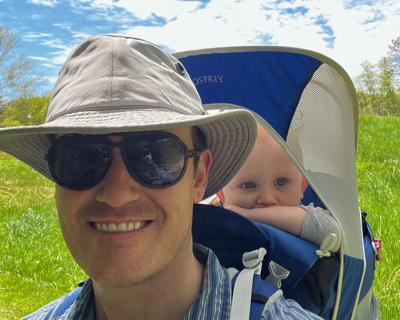Helping patients lead healthier lives by bridging gaps in their access to community resources, exercise technology and education
Before becoming a physician, Matthew Kampert, DO, (FM’19, PC/SM’20), was an exercise physiologist. In that role, he says, he saw firsthand how people improved their health through lifestyle choices. He wanted to help influence the direction of healthcare, turning it toward disease prevention. In December 2018, as a family medicine resident at Cleveland Clinic South Pointe Hospital, he got that chance.
Advertisement
Cleveland Clinic is a non-profit academic medical center. Advertising on our site helps support our mission. We do not endorse non-Cleveland Clinic products or services. Policy
With the help of a mentor, Debasis Sahoo, MD, (IM’11, PULMCC’14), a pulmonary specialist on the staff of the Cleveland Clinic Respiratory Institute, he established a research study called THE BRIDGE PROJECT. The name was inspired by Dr. Kampert’s father, who built bridges, and the prospect of helping patients lead healthier lives by bridging gaps in their access to community resources, exercise technology and education. The name is an acronym for “Targeted Healthcare Efforts to Bridge Resources, Improve the Development of Guideline-Based Exercise Prescription and Reduce Obesity by Joining Education, Community and Technology.”
The research project drew 30 participants, all with a BMI over 30. Their resting metabolic rate also was measured to determine how many calories they burned in a 24-hour period, and cardiopulmonary exercise tests determined how much oxygen they consumed while exercising and how hard their hearts worked as they did so.
Participants were attracted by the offer of YMCA gym memberships, as well as one-on-one patient education, medical appointments and progress assessments for six months. To remain in the study for an additional six months, they had to meet set goals for exercise and weight loss.
Dr. Kampert, now a sports medicine fellow, says he strongly believes in the need to “invest time in our patients now. That can pay off in the long run for them, the healthcare system, insurance providers and the community as a whole.”
The study’s one-year goal was for participants to have become independent exercisers. “They also know how to eat, when to eat, how to exercise,” Dr. Kampert says. “They know how to pick themselves up when they slip, how to overcome obstacles. Behavioral intervention in the study gives them the tools and cues to recognize when they are off track and know how to come back to center. After one year, they have changed as people — now, they are exercisers.”
Advertisement
Dr. Sahoo, who helped develop the protocols and obtain internal approvals to conduct the study, which has concluded, says he is encouraged by the participants’ progress and impressed by Dr. Kampert’s vision.
“As physicians, we are only trying to treat the sick,” he says. “If we change that goal and work to get people healthy, we are solving a big problem in our society. That’s what fascinated me. We are self-motivating patients. We are not just taking care of medical problems but also making sure that the community can get healthier than they are now.”
Advertisement
Advertisement

We celebrate the exceptional achievements of four future alumni

Honoring Exceptional Achievement and Leadership

We celebrate the exceptional achievements of four future alumni

Meet Hardeep Phull, MD (CCLCM’11)

Meet William Tierney, MD, MS (CCLCM’16, OTO’18)

Meet Samuel Omotoye, MD (CARD/E'15)